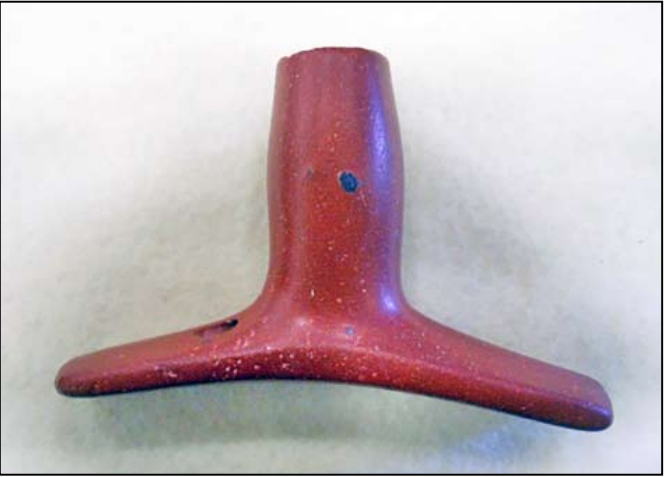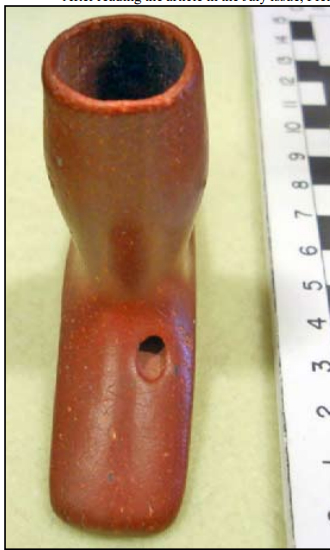|
This excerpt from "An Interesting Feature
on Two Hopewell Pipes" published in the 2024 Central States Archaeological Societies 2024
October Journal
Read the complete column in the Central States
Archaeological Societies 2024
October Journal which can be purchased on-line after March 2025 |
 |
Figure 1. Side view of a Hopewell pipe
found in northeast Kansas. It measures 4” in length
|
Over the years the Central State Archaeological Society journals have had
interesting articles, and at times information about artifacts that I was
not aware of. However, the most important ones are those that provide insight
about how a particular function of an artifact worked or was utilized.
A case in point was the article “Uncovering the Background of a Havana
Style Hopewell Pipe” in the CSAJ 70 (3) (July 2023) pages 174 and175.
There were several interesting things about this article. First the proper
name “Havana” for this style of Hopewell pipe was new to me (Fig.
2). More importantly, it may have a start of a unique feature that I first
saw on a Hopewell pipe a few years ago (Fig. 1). Since then, I have been
wanting to get a better feel about this feature and how widespread it was
used. Hopefully this article will help answer that question from responses
received.
My original exposure to this feature occurred at our annual Holton KAS artifact
show in September 2021. It started when Dave, our KAS President, asked if
I had seen the super pipe that a new collector had found (Fig. 1). It was
surely beginners’ luck!2 The new collector was showing it around trying
to get information about it. Dave pointed him out and I went over to take
a look. The finder was willing to show it to me because he was wanting information
about it.
The first thing I pointed out is that it was made from pipestone a.k.a.
Catlinite, which also had been mentioned to him by others.3 So I gave him
some history about the material and its source location in southwest Minnesota,
and that Indians have quarried there for 3,000 years (Fig. 3).
I asked him to lay it on a table so I could look at it safely, since a concrete
floor is not forgiving if you drop an artifact on it (some people find this
out the hard way). Next, I confirmed as others had, that it was very nicely
made but had not yet been recognized as a Hopewell pipe! 5
Since it was found in northeast Kansas, I pointed out that there was a major
Hopewell outpost in the Kansas City area. The pipe had an unusual feature
on the upper side opposite of the pipe stem opening; a small hole had been
drilled into the top side of the upper rear platform (Figs. 5, 6).
When I mentioned this feature to the finder, he said he thought that the
Indian had drilled through it when drilling the opening for the stem which
was on the opposite side. I am puzzled as by this, since I had never viewed
anything like it before on a pipe.
I told him I did not believe that is what had occurred, due to the way the
odd opening was drilled. I stated to him that I thought the additional opening
had been made on purpose to allow more air so the tobacco would burn better.
This action would be similar to a flue on a chimney or an up-draft port
on a carburetor, thus making it easier to smoke the pipe. I informed him
this was the first time I have ever seen anything like that on...
Read other great columns in the Central States Archaeological Societies 2024
October Journal which can be purchased on-line after March 2025
|
This excerpt from "An Interesting Feature
on Two Hopewell Pipes" published in the 2024 Central States
Archaeological Societies 2024
October Journal
Read the complete column in the Central States
Archaeological Societies 2024
October Journal which can be purchased on-line after March 2025
|
 |
Figure 5. The rear platform of the pipe found
in Kansas, showing the location of the updraft hole.
|




